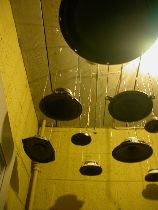 Minna Dubin told you about “Scarab” in her great post and I just want to jump in here with some pictures and a few thoughts.
Minna Dubin told you about “Scarab” in her great post and I just want to jump in here with some pictures and a few thoughts.
My sketch at PW on July 28 will have more. (top image is detail of speakers hovering like a flying saucer invasion in Robert Chaney’s “Green Hell” in the bathroom. Next is Drew Elliott’s “Untitled” pen and ink devil)
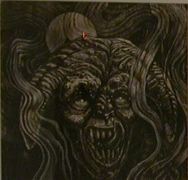
Where I want to start is with a brief chat I had with Dario Robleto yesterday before he gave his “Food for Thought” talk at Uarts. (Libby tells you more about that in her post right below).
Robleto, 31, featured in this year’s Whitney Biennial, is influenced by music, and his work uses a kind of visual sampling (dj’ing), he says.
We were talking about the preponderance of the “goth” aesthetic in art today (dark, nihilistic work — there was a bunch in the Biennial…there’s been a bunch out there in general). (below is Scott Cassidy’s “Shoe”)
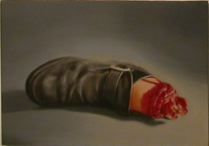
Robleto says he’s against that kind of dark glam work, and he says his new project is fighting against it. He mentioned that in one of the Biennial panel discussions he took this oppositional position.
I found that most interesting because to my mind Robleto’s Biennial work was some of the darkest, most difficult work to view — mostly having to do with his use of transgressive materials (human bones) and the forlorn, thrift shop affect his objects take on. If the spirit of that work is meant to be anti-goth, I’m not sure the hermetically-sealed work captures it.

Work exploring the dark side has always been a stream in art — Hieronymus Bosch, Dante, Warhol’s electric chairs, etc. It’s a reflection of dark times. To a certain extent people have to wallow in the cellar in order to finally reject it and move on and up. Right now we seem to be wallowing. We’ll move on. (right is Chris Bors’ “Slayer…Slayer…Slayer” video)
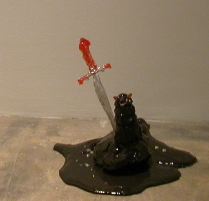
Scarab, meanwhile, sets about wallowing in style. The artists, all of whom were influenced by metal music — high goth — make work that while worshipful is also a little contrary.
(Left is Paul Swenbeck’s polychromed resin,”My Only Son, A Demon,” and right is a detail from Justin Matherly’s black on black spray paint piece “A Blaze in the Northern Sky”)

Black is the signature color for goth work, and here it shows up in Matherly, Swenbeck, and Elliott’s works.
Red is the other signature color and it’s there too, in Cassidy’s iconic boot and two other paintings (a severed hand and a still life with skull). It’s also there is Chris Bors’ wonderful oral history video in which red lips tell the story of a teen’s first Slayer concert. This endearing work focusses on big red lips (Rocky Horror Picture Show comes to mind). But what you hear is the kid’s tale (full of kid language — “I’m like this … My dad’s was like…and my mom’s like …”). I found myself rooting for the kid in his trippy journey that was — at bottom — about getting home to mom and dad.
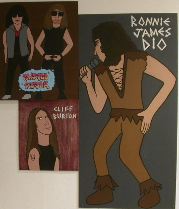
Thom Lessner’s signature portrait paintings (detail shown) of metal bands and two miniature painted guitars add a note of straight-forward fan worship.
I saved my favorites for last — Clint Takeda’s “Iommi Digits (the Birth of Heavy Metal)” (below) and A. Ho’s “Satan, sitting there, he’s smiling” (bottom).
Takeda’s plastic and leather finger thimbles in a glass vitrine re-create the faux fingertips guitarist Tony Iommi of Black Sabbath invented for himself in order to continue playing guitar after losing two fingertips in some accident or other.
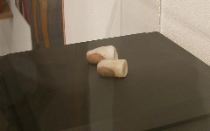
I found this work, which would fit perfectly in the Rock and Roll Hall of Fame and in the U. S. patent office collection of prostheses invented for disabled guitarists, took the show to another level altogether.
By dwelling on the disability of Iommi, Takeda takes the metal guitar god down a notch — and at the same time raises him up to a level of inventor, a la Ben Franklin. In either case, he’s made him less satanic and more human.
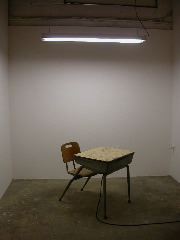
Finally, A. Ho’s desk in the corner (left) is a perfect piece — a reminder of the teen torture chamber, high school, where goth is a term of definition. Like most of the work in the show, Ho’s installation is an adoring artifact to the church of metal and part question mark. For carrying on that double-edged conversation I loved the piece.
Scarab closes with a panel discussion Friday, Aug, 13 at 7 p.m. I hope the discussion turns to the issue of goth imagery in today’s art world and whether it feels to the artists like cathartic wallowing. (I bet it does.)
I also want to know what the artists think is goth art’s second act.









